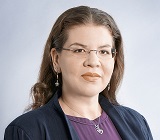The face of law is changing. According to the Law Society of Ontario, about 43 per cent of lawyers are women. And the final report released in 2016 from the Law Society’s Challenges Faced by Racialized Licensees Working Group noted that the proportion of racialized lawyers in Ontario doubled between 2001 and 2014, from 9 per cent to 18 per cent. In an effort to highlight the diverse range of individuals working across the legal landscape, we are pleased to present our new series, This is What a Lawyer Looks Like. The goal of this series is to put racialized and Indigenous women lawyers in the spotlight and amplify their voices in the conversation about gender equality.
Do you know someone we can feature? Send a note to the editor.
 ALEXANDRIA WINTERBURN
ALEXANDRIA WINTERBURN
Senior Associate, Pape Salter Teillet LLP
What is your year of call, area of practice and reason you chose your practice area?
Called: 2012 (Ontario) and 2018 (Manitoba).
Practice area: Aboriginal law.
Reason I chose this practice area: In undergrad I started taking Native Studies course at the University of Alberta. It struck me that so many of the issues that Indigenous communities and Peoples face today can trace their roots to legal issues or Canadian laws (e.g. Indian Act, residential schools, treaties, land claims, etc.). There is a legal framework behind all of it. And I thought that if I really wanted to change these injustices then I needed to better understand the law, as a colonial tool that has done so much harm, and how I could use it as a decolonizing tool to try and restore justice. Doing this work is why I went to law school and I am lucky enough to do it every day.
Tell us a bit about your practice today.
Today, I am a senior associate with Pape Salter Teillet LLP, a boutique Aboriginal law firm in Toronto and Vancouver. We exclusively represent Indigenous Peoples and communities across Canada. My practice focuses mostly on the areas of treaty rights and self-government/modern treaty negotiations as well as the duty to consult, honour of the Crown and related duties. I dabble in litigation and regulatory work also.
You went into private practice from government. How has that shaped how you practice law?
Surprisingly, working for Indigenous Peoples—and specifically rights-holding Indigenous governments—is pretty similar to working for the provincial government. Your clients in both cases have a mix of legal, policy, and political issues that you need to grapple with.
The challenge on the Indigenous side of things is often resources. Provincial/Federal/Territorial governments have a lot of resources at their disposal comparatively, whereas a big part of what I consider my job to be is advocating to ensure that the work I can do for my clients now is being appropriately resourced and funded so that they’re not in a position of having to decide between the legal advice they need and the funding that they need to provide housing, or water, or supports for their communities.
I spent 5 years with the provincial government and ultimately learned a lot about how government works from the inside that I’ve carried with me to help me be a better advocate for my clients.
Please log in to read the full article.